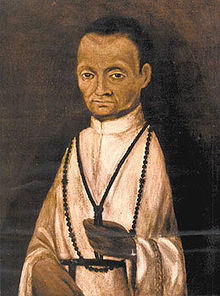Martín de Porres
| Saint Martin de Porres, O.P. | |
|---|---|

Portrait of St. Martin de Porres, c. 17th century, Monastery of Rosa of Santa Maria in Lima. This portrait was painted during his lifetime or very soon after his death, hence it is probably the most true to his appearance.
|
|
| Martin of Charity Saint of the Broom |
|
| Born |
December 9, 1579 Lima, Viceroyalty of Peru |
| Died | November 3, 1639 (aged 59) Lima, Viceroyalty of Peru (modern-day Peru) |
| Venerated in | Roman Catholic Church, Lutheran Church, Anglican Communion |
| Beatified | 1837 by Pope Gregory XVI |
| Canonized | May 6, 1962, by Pope John XXIII |
| Major shrine | Church of Santo Domingo, Lima, Peru |
| Feast | November 3 |
| Attributes | a dog, a cat, a bird, and a mouse eating together from a same dish; broom, crucifix, rosary, a heart |
| Patronage | Diocese of Biloxi, Vietnam, Mississippi, black people, hair stylists, innkeepers, lottery, lottery winners, mixed-race people, Peru, poor people, public education, public health, public schools, race relations, social justice, state schools, television, Mexico, Peruvian Naval Aviators |
Martin de Porres Velázquez, O.P. (December 9, 1579 – November 3, 1639), was a lay brother of the Dominican Order who was beatified in 1837 by Pope Gregory XVI and canonized in 1962 by Pope John XXIII. He is the patron saint of mixed-race people, barbers, innkeepers, public health workers, and all those seeking racial harmony.
He was noted for work on behalf of the poor, establishing an orphanage and a children's hospital. He maintained an austere lifestyle, which included fasting and abstaining from meat. Among the many miracles attributed to him were those of levitation, bilocation, miraculous knowledge, instantaneous cures, and an ability to communicate with animals.
Juan Martin de Porres Velázquez was born in the city of Lima, in the Viceroyalty of Peru, on December 9, 1579. He was the illegitimate son of a Spanish nobleman, Don Juan de Porres, and Ana Velázquez, a freed slave from Panama, of African or possibly part Native American descent. He had a sister named Juana, born two years later in 1581. After the birth of his sister, the father abandoned the family. Ana Velázquez supported her children by taking in laundry. He grew up in poverty and, when his mother could not support him, Martin was confided to a primary school for two years, and then placed with a barber/surgeon to learn the medical arts. He spent hours of the night in prayer, a practice which increased as he grew older.
By law in Peru, descendants of Africans and Indians were barred from becoming full members of religious orders. The only route open to Martin was to ask the Dominicans of Holy Rosary Priory in Lima to accept him as a donado, a volunteer who performed menial tasks in the monastery in return for the privilege of wearing the habit and living with the religious community. At the age of 15 he asked for admission to the Dominican Convent of the Rosary in Lima and was received first as a servant boy, and as his duties grew he was promoted to almoner.
...
Wikipedia
